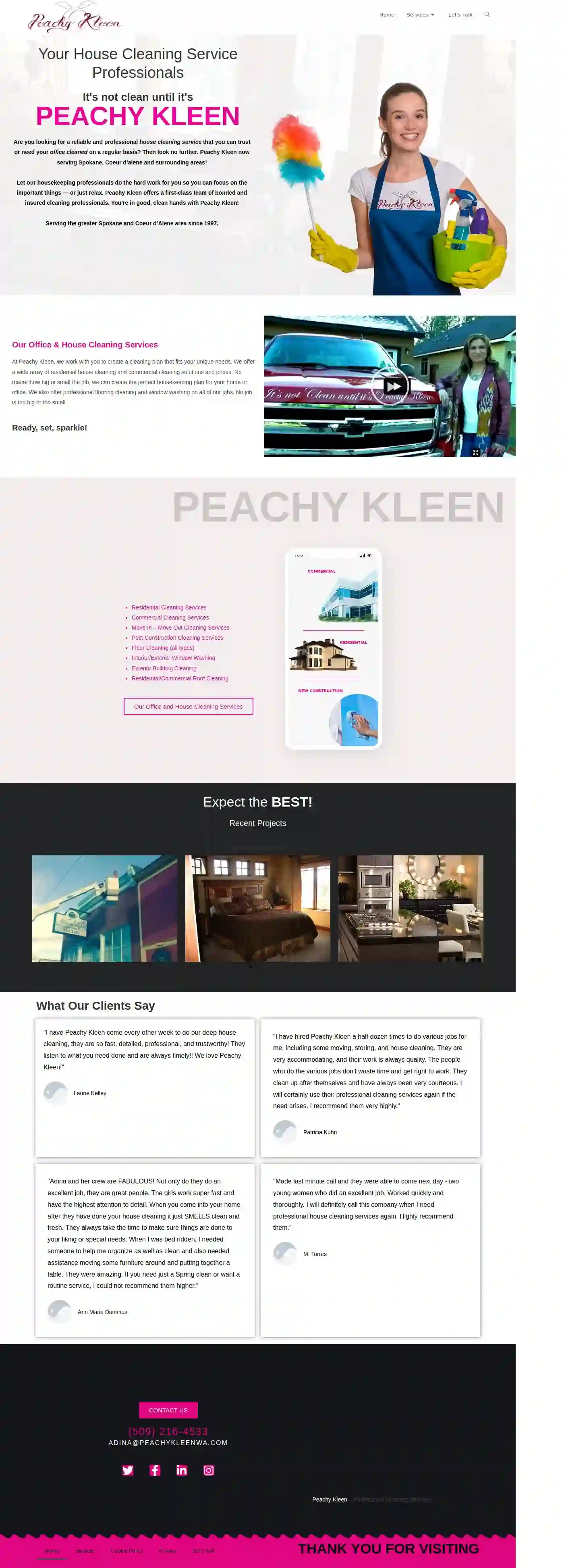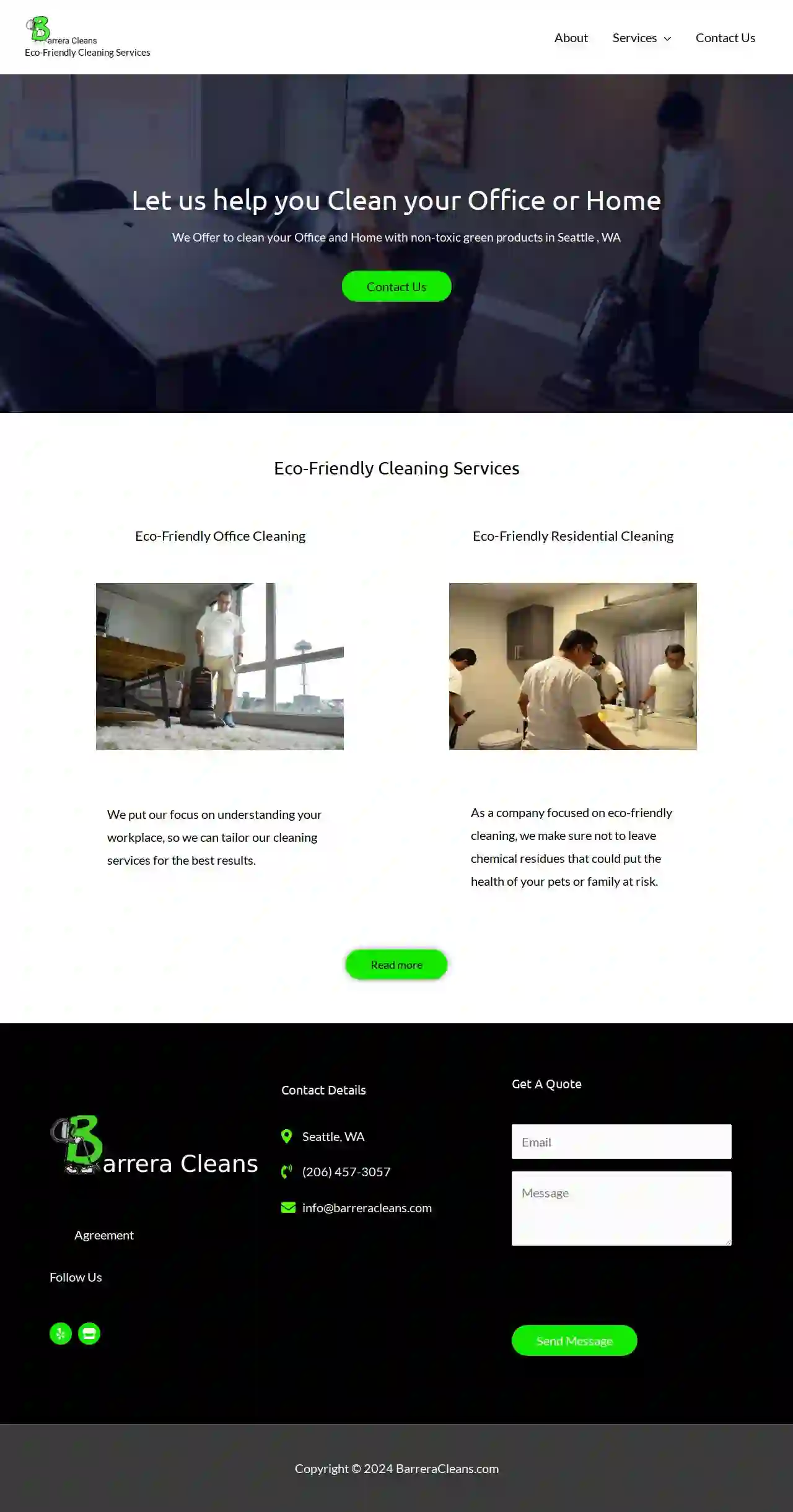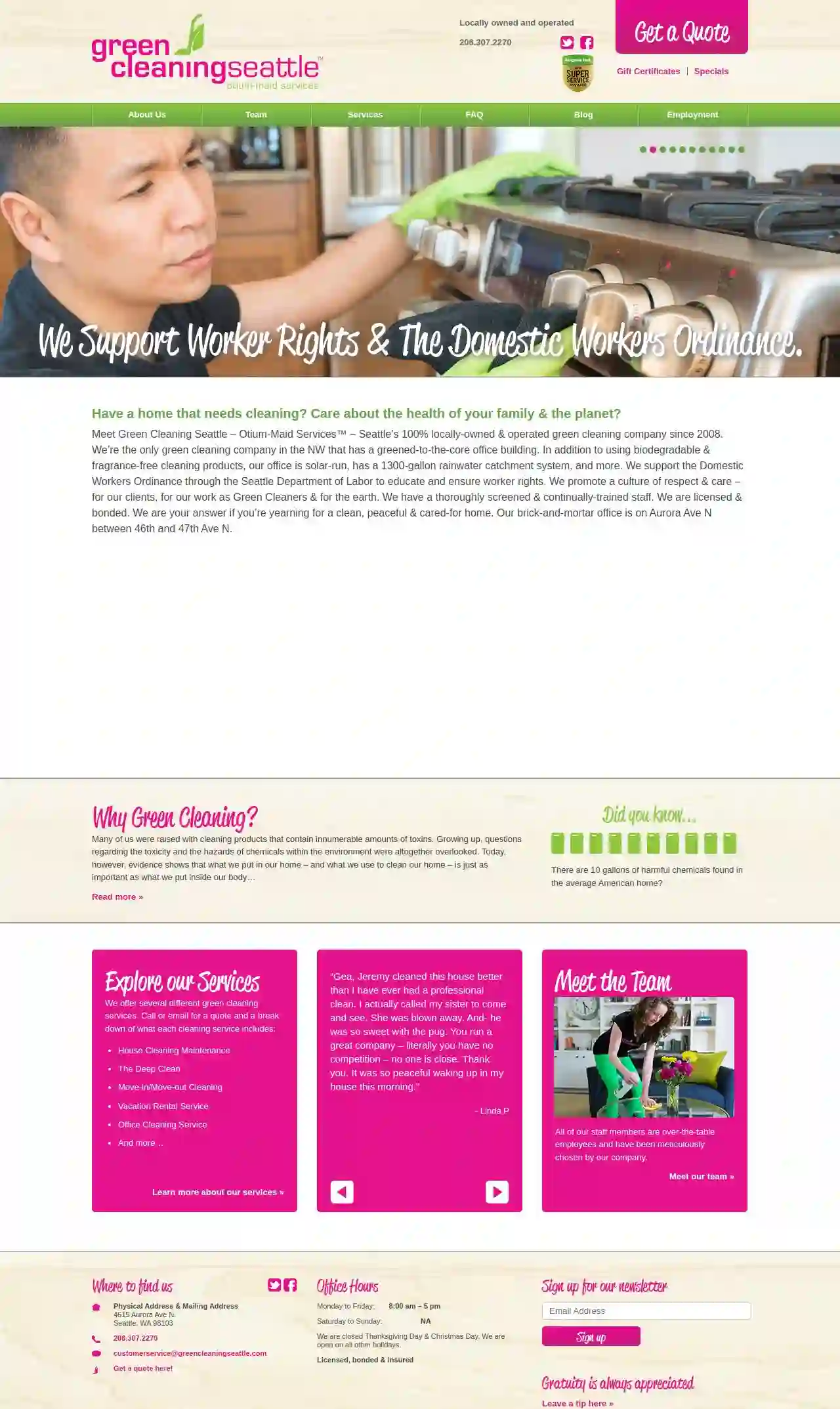Cleaning Services Des Moines
Top 10 Cleaning Services in Des Moines
Receive 3 FREE Cleaning Services quotes for your project today! Compare profiles, reviews, accreditations, portfolio, etc... and choose the best offer.

Peachy Kleen
425 reviewsSpokane, US- Services
- Why Us?
- Gallery
Get Quote
Barrera Cleans
55 reviewsSeattle, US- Services
- Why Us?
- Gallery
Get Quote
Cleaners Kingdom
531 reviewsSeattle, US- Services
- Why Us?
- Gallery
Get Quote
LPM Supply Inc
513 reviews1504 W Boone Ave, Spokane, 99201, USYou’re facing big clean-up on a short timeline. You need products and equipment that you can depend on, tailored for the job. LPM Supply has been in business for 45 years, and our staff has over 100 cumulative years’ experience. We know our products, our equipment (including how to repair them), and our industry. We have IICRC certifications in mold, carpet, fire, flood, tile and grout. We sell the products that work, and we’ll teach you the best methods to use them. From products to equipment to classes, we’re your expert. And we’re only a phone call or a visit away. Cleaning supplies you can count on! With experts with you every step of the way LPM Supply offers effective commercial cleaning supplies and equipment for the Inland Northwest, including the greater Spokane area. We repair commercial cleaning equipment and offer continuing CEC credit classes around the region. You deserve to get the job done right, with supplies that work and won’t break the bank, and with experts in your corner to make it as easy as possible.
- Services
- Why Us?
- Accreditations
- Gallery
Get Quote
Bluegrass Commercial Cleaning
4.58 reviewsKent, US- Services
- Why Us?
- Gallery
Get Quote
NW Maids House Cleaning Service of Seattle
4.3330 reviewsSeattle, US- Services
- Why Us?
- Gallery
Get Quote
Cleanstart
4.873 reviewsSeattle, US- Services
- Why Us?
- Gallery
Get Quote
Green Cleaning Seattle - Otium-Maid Services™
4.598 reviewsSeattle, US- Services
- Why Us?
- Gallery
Get Quote
Concord Clean
532 reviewsKent, US- Services
- Why Us?
- Gallery
Get Quote
T & H MaintenancePro101
51 reviewsSeattle, US- Services
- Why Us?
Get Quote
Over 60,241+ Janitorial Services onboarded
Our cleaning contractors operate in Des Moines & beyond!
CleaningMatch has curated and vetted Top Janitorial Companies near Des Moines. Find a top & reliable contractor today.
Frequently Asked Questions About Cleaning Services
- Regular Sweeping or Dust Mopping: Sweep or dust mop hardwood floors daily to remove dust, dirt, and debris.
- Vacuuming: Vacuum hardwood floors weekly using a vacuum cleaner with a hardwood floor attachment to avoid scratches.
- Damp Mopping: Damp mop hardwood floors with a hardwood floor cleaner as needed. Avoid excessive water, as it can damage the wood.
- Prevent Scratches: Place felt pads under furniture legs to prevent scratches. Avoid dragging heavy objects across the floor.
- Avoid Harsh Cleaners: Do not use harsh chemicals, abrasive cleaners, or furniture polish on hardwood floors.
- Professional Cleaning: Consider hiring a professional hardwood floor cleaning service for deep cleaning and refinishing as needed.
- Frees up your time: Cleaning can be time-consuming, especially for larger properties or busy individuals. Hiring a cleaning service allows you to focus on other priorities, such as work, family, or leisure activities.
- Ensures a deeper clean: Professional cleaners are trained in effective cleaning techniques and have access to specialized equipment, resulting in a more thorough clean than you might achieve on your own.
- Reduces allergens and improves hygiene: Thorough cleaning removes dust, allergens, and germs, creating a healthier living environment, particularly for those with allergies or sensitivities.
- Reduces stress and improves well-being: Coming home to a clean and tidy home can reduce stress and promote a sense of calm and order.
- Declutter Regularly: Set aside time regularly to declutter your belongings. Donate, sell, or discard items you no longer use or need.
- Designated Storage: Assign specific storage spaces for different items, such as shelves for books, drawers for clothes, and containers for toys.
- Labeling: Label storage containers and drawers to make it easy to find items and put them back in their designated places.
- 'One In, One Out' Rule: For every new item you bring into your home, get rid of an old one. This prevents clutter from accumulating.
- Vertical Storage: Utilize vertical storage solutions, such as shelves, wall organizers, and hanging racks, to maximize space.
- Digital Organization: Organize digital files and emails to reduce paper clutter. Use cloud storage services to free up space on your computer.
- White Vinegar: A versatile cleaner that cuts through grease, removes stains, and deodorizes. Mix equal parts water and vinegar for a general-purpose cleaner.
- Baking Soda: A natural abrasive and deodorizer. Sprinkle baking soda on surfaces, let it sit, then scrub and rinse.
- Lemon Juice: Acts as a natural bleaching agent and disinfectant. Mix lemon juice with water for a cleaning solution or use it directly on stains.
- Castile Soap: A gentle and biodegradable soap made from plant oils. Mix a few drops of castile soap with water for a versatile cleaning solution.
- Essential Oils: Add a few drops of essential oils like tea tree oil or lavender oil to cleaning solutions for a natural fragrance and antibacterial properties.
What are some tips for cleaning hardwood floors?
By following these tips, you can keep your hardwood floors looking beautiful for years to come.
Are cleaning services worth it?
If you value these benefits and find the cost justifiable, cleaning services can be a worthwhile investment in your time and well-being.
What are some tips for keeping my home organized and clutter-free?
By adopting these strategies, you can create a more organized and clutter-free home, promoting a sense of calm and efficiency.
What are some eco-friendly cleaning solutions?
Remember to test these solutions on a small, inconspicuous area first to ensure they don't damage delicate surfaces.
What are some tips for cleaning hardwood floors?
- Regular Sweeping or Dust Mopping: Sweep or dust mop hardwood floors daily to remove dust, dirt, and debris.
- Vacuuming: Vacuum hardwood floors weekly using a vacuum cleaner with a hardwood floor attachment to avoid scratches.
- Damp Mopping: Damp mop hardwood floors with a hardwood floor cleaner as needed. Avoid excessive water, as it can damage the wood.
- Prevent Scratches: Place felt pads under furniture legs to prevent scratches. Avoid dragging heavy objects across the floor.
- Avoid Harsh Cleaners: Do not use harsh chemicals, abrasive cleaners, or furniture polish on hardwood floors.
- Professional Cleaning: Consider hiring a professional hardwood floor cleaning service for deep cleaning and refinishing as needed.
By following these tips, you can keep your hardwood floors looking beautiful for years to come.
Are cleaning services worth it?
- Frees up your time: Cleaning can be time-consuming, especially for larger properties or busy individuals. Hiring a cleaning service allows you to focus on other priorities, such as work, family, or leisure activities.
- Ensures a deeper clean: Professional cleaners are trained in effective cleaning techniques and have access to specialized equipment, resulting in a more thorough clean than you might achieve on your own.
- Reduces allergens and improves hygiene: Thorough cleaning removes dust, allergens, and germs, creating a healthier living environment, particularly for those with allergies or sensitivities.
- Reduces stress and improves well-being: Coming home to a clean and tidy home can reduce stress and promote a sense of calm and order.
If you value these benefits and find the cost justifiable, cleaning services can be a worthwhile investment in your time and well-being.
What are some tips for keeping my home organized and clutter-free?
- Declutter Regularly: Set aside time regularly to declutter your belongings. Donate, sell, or discard items you no longer use or need.
- Designated Storage: Assign specific storage spaces for different items, such as shelves for books, drawers for clothes, and containers for toys.
- Labeling: Label storage containers and drawers to make it easy to find items and put them back in their designated places.
- 'One In, One Out' Rule: For every new item you bring into your home, get rid of an old one. This prevents clutter from accumulating.
- Vertical Storage: Utilize vertical storage solutions, such as shelves, wall organizers, and hanging racks, to maximize space.
- Digital Organization: Organize digital files and emails to reduce paper clutter. Use cloud storage services to free up space on your computer.
By adopting these strategies, you can create a more organized and clutter-free home, promoting a sense of calm and efficiency.
What are some eco-friendly cleaning solutions?
- White Vinegar: A versatile cleaner that cuts through grease, removes stains, and deodorizes. Mix equal parts water and vinegar for a general-purpose cleaner.
- Baking Soda: A natural abrasive and deodorizer. Sprinkle baking soda on surfaces, let it sit, then scrub and rinse.
- Lemon Juice: Acts as a natural bleaching agent and disinfectant. Mix lemon juice with water for a cleaning solution or use it directly on stains.
- Castile Soap: A gentle and biodegradable soap made from plant oils. Mix a few drops of castile soap with water for a versatile cleaning solution.
- Essential Oils: Add a few drops of essential oils like tea tree oil or lavender oil to cleaning solutions for a natural fragrance and antibacterial properties.
Remember to test these solutions on a small, inconspicuous area first to ensure they don't damage delicate surfaces.